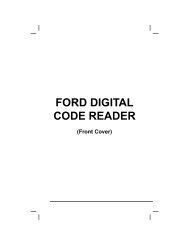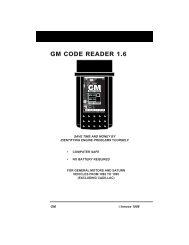Create successful ePaper yourself
Turn your PDF publications into a flip-book with our unique Google optimized e-Paper software.
GM OBD1 Systems<br />
CODE RETRIEVAL PROCEDURE<br />
In the case of long code definitions, a small arrow is shown in the<br />
upper/lower right-hand corner of the code display area to indicate<br />
the presence of additional information. Use the and<br />
buttons, as necessary, to view the additional information.<br />
Code 12 will always be present and it has one of the following meanings:<br />
� If code 12 is the only DTC retrieved and your vehicle "STARTS OK"<br />
then code 12 indicates system "PASS" and all computer control<br />
systems are functioning properly.<br />
� If code 12 is present and your vehicle "DOES NOT START", then it<br />
may indicate a problem with the ignition control system.<br />
8. Disconnect the Tool from the vehicle and turn the ignition key OFF.<br />
9. To prolong battery life, the Tool automatically shuts "Off" after<br />
approximately three minutes with no button activity. The DTCs<br />
retrieved will remain in the Tool's memory, and may be viewed at<br />
any time. If the Tool’s batteries are removed, or if the Tool is relinked<br />
to a vehicle to retrieve codes, any prior codes in its memory<br />
are automatically cleared.<br />
10. Follow the testing and repair procedures outlined in the vehicle's<br />
service repair manual to correct "hard" DTCs. Codes should be<br />
addressed and eliminated in the order they were received, erasing<br />
(see SERVICING DTCs - OBD I on page 97) and retesting after<br />
each repair is made to be sure the fault was eliminated. Code 12 will<br />
appear alone when no other fault codes are present.<br />
� It may be necessary to test drive the vehicle to reset "hard" fault<br />
codes 13, 15, 24, 44, 45, and 55 after they have been erased.<br />
Whenever codes 51, 52, 54, or 55 are displayed with other<br />
codes, troubleshoot and eliminate the "50 Series" codes first,<br />
then proceed with the lower numbered codes.<br />
The green, yellow and red LEDs are used (with the LCD<br />
display) as visual aids to make it easier to determine engine<br />
system conditions. See SERVICING DTCs - OBD I on page 97<br />
for information on interpreting LEDs and servicing DTCs.<br />
88 OBD2&1




